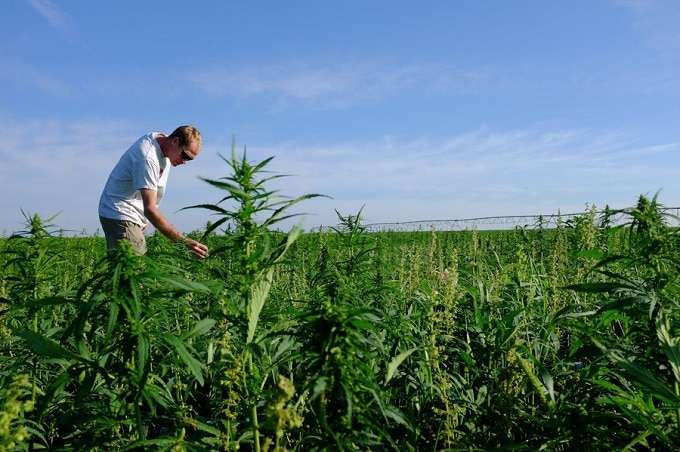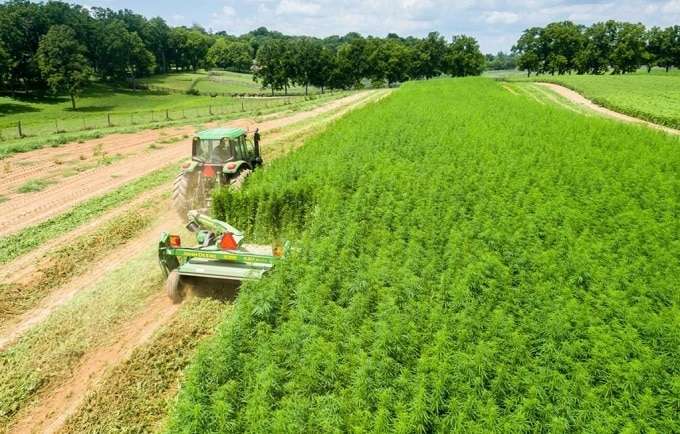What is the best CBD hemp oil? After all, not All CBD oil is equal. For example, some CBD-rich hemp is grown on a Kentucky farm without any pesticides and washed by hand. Other types of hemp are grown on a Chinese “farm” outside a factory that makes iPhone batteries next to a polluted river that smells like battery acid.
Perhaps that is an exaggeration, but not all CBD oil is created equally.
We will explain.
Although industrial hemp has been legal to import from Canada, China, and Europe – until very recently, growing hemp in the United States has been illegal since 1937.
That’s right.
You can import hemp from a chemical wasteland in Southeast Asia, but you can’t grow it in the ground of the United States to make paper or necklaces.
Thankfully, the 2014 Agricultural Act (known in the CBD community as “The Farm Bill“) allows states to grow limited amounts of non-psychoactive hemp if they participate in a federal pilot program.
Many American farmers jumped at the chance to legally grow this strong, beautiful, versatile plant that used to be a cash crop in the United States before 1937.
Yet much of the CBD hemp oil on the American market comes from “parts unknown” and “farming practices unknown”.
CBD Hemp Oil is Not Always Good
CBD comes from hemp. It matters where the hemp comes from. And it matters a lot.
Although the primary ingredient is cannabidiol (CBD), there is an entire spectrum working together.
Including: Multiple flavonoids, terpenes, phytonutrients, neuroprotective antioxidants and other lesser discussed cannabinoids.
All of these affect your overall experience.
You want all of these present and working together. This is called the Entourage Effect.
The entourage effect is the synergistic relationship between CBD and other cannabinoids, flavonoids, and terpenes found in cannabis plants like hemp and marijuana.
Discover: CBD Oil on Amazon
Cannabinoids are natural compounds found mostly in cannabis plants. THC (tetrahydrocannabinol), CBD (cannabidiol), and CBG (cannabigerol) are all examples of cannabinoids. Each cannabinoid has its own properties and benefits.
Flavonoids are the phytonutrients which are responsible for the vivid non-green colors we see in plants.
The color of shiny red apples and beautiful blueberries is all due to their unique flavonoid profile.
Commonly known flavonoids include catechins (found in green tea) and quercetin (found in cannabis, fruits, and vegetables).
Flavonoids are known to have antiviral, antioxidant, and anti-inflammatory effects (especially the flavonoids found in cannabis)
Terpenes are the essential oils found in all plants. These compounds are responsible for the uplifting smell of a fresh tangerine or the unmistakable sharpness of pine needles.
Common terpenes are limonene (found in citrus fruits) and linalool (found in lavender). Terpenes have therapeutic effects on the human body.
The practice of aromatherapy is based on the use of terpenes.
All of these components work best when consumed together as opposed to in isolation.
Hemp plants grown specifically for CBD have more resin in their flowering buds.
These plants contain more of the beneficial cannabinoids, terpenes, and flavonoids you want in your CBD hemp oil.
While all hemp plants contains some level of these compounds throughout all parts of the plant (such as the flower, stalk, and seeds), there is no comparison to the higher levels contained in the flowers of hemp strains specifically grown for cannabinoid extraction.
Hemp flowers have the highest concentration of cannabinoids, terpenes, and flavonoids.
Many CBD hemp oil products are sourced from hemp that is grown overseas in various parts of Europe.
Some of the hemp may also come from Asia. The CBD is extracted from the stalk and seed of these plants, not the flowers.
Overseas hemp farmers generally do not focus on making their hemp crop produce big, resiny flowers.
This is important because the resin contains the highest concentration of cannabinoids. Thus the more resin, the more cannabinoids.
European and Asian hemp farmers have been growing hemp in large, densely populated fields for hundreds of years.
This is the kind of hemp that’s grown for fiber production. So the focus is on the stalk and seeds of the plant, not the flowers.
To be able to safely import hemp products from overseas within the restrictions of the law, hemp importers extract CBD only from the legally exempt parts of the cannabis plant: the stalk and the seeds.
American CBD Hemp Oil is HOT
CBD Hemp Oil Actually From CBD Rich Plants
The end product is a very rich CBD hemp Oil with the full spectrum of nutrients to enhance the effects.
While some of the CBD hemp oil products from European and overseas hemp may be good, they are most often inferior to American grown hemp strains which are grown specifically for CBD oil.
You need CBD from the flowers of hemp specifically grown for CBD oil – not from the stalks and seeds of standard industrial hemp normally used for fiber and food products.
Our understanding is that the focused effort and growing practices used by American hemp farmers results in a higher quality product than what you can get from standard industrial hemp from overseas.
When hemp is grown to maximize cannabinoid content, as opposed to its stalks and seeds for fiber or food, you get a better supplement with more cannabinoids, terpenes, and flavonoids for your health (and with a maximal Entourage Effect)!
American Hemp Won’t “Accidentally” Contain Toxins!
This one’s interesting.
You’ll want to know this if you supplement with CBD hemp oil on a daily basis.
There is another reason why American grown hemp for CBD extraction is superior to overseas hemp.

Hemp plants are efficient “bioaccumulators”.That means that they are very good at absorbing toxic substances from the earth.
While this is great for the earth, it may not be so good for you if those toxic substances end up in your hemp extract supplements.
Because industrial hemp plants from overseas contain minimal amounts of CBD (~ 3.5%), a lot of hemp plants are needed for processing them into CBD hemp extracts.
Our thoughts are that the higher quantity of plants needed for processing will result in a greater likelihood of toxins getting into the end product — the hemp extract you will be consuming.
American farmers who grow hemp for CBD extraction grow specially bred strains with higher concentrations of CBD (~ 12% – 20% CBD content).
The most famous of these special strains of hemp is known as Charlotte’s Web.
Expert growers also produce their own proprietary genetic strains of high CBD, low THC (< 0.3%) breeds.
American CBD hemp farmers grow far less individual plants than the hemp farmers overseas — because they don’t need to!
The special hemp strains produce so much CBD containing resin that American farmers can afford to give their plants lots of individualized attention, love, and care.
Our argument is that the focus and attention given to American CBD hemp plants by the farmers who grow them will lead to a superior, cleaner product than what you can get from overseas.
America – the Hemp and CBD Heartland
American farmers are growing hemp for textiles, food, and cannabinoids.
The cannabinoids, especially CBD, is where our interest lies.
In much the same way as medical marijuana growers are very selective of how they grow their crop, American hemp growers are taking the same approach to how they grow their CBD rich hemp plants.
American farmers who are growing hemp for CBD extraction:
- Grow special varieties and strains of hemp which are known for their high CBD content
- Focus on female hemp plants to get the most flowers
- Use special growing techniques to encourage maximum flower production
- Give their hemp plants lots of space to grow big and bushy
- Give their hemp plants individualized love and care (quality over quantity)
The practices of American hemp for CBD farmers are similar to those of marijuana for THC growers.
If you walked onto one of their hemp fields, you might think you were actually standing in a field of outdoor marijuana in Northern California.
But it’s not marijuana. It’s hemp.
And the department of agriculutre of each state with a hemp pilot program is very strict about making sure of that.
All American hemp fields are subject to rigorous testing to ensure their crops do not contain more than 0.3% THC.
The growing practices of American hemp for CBD farmers is very, very different from the way hemp is grown when it’s intended to be used as a food or textile product.

That sort of hemp is grown in very dense fields of many plants growing side by side to each other.
That sort of hemp is grown mainly for its stalk and seeds, not for its flowers.
Remember though, it’s all the same plant. It’s all hemp. It’s just grown in different ways for different purposes.
The hemp grown for food and textile products is lower in CBD content and cannabinoids when compared to the hemp that’s grown for CBD extraction.
In terms of numbers:
Standard industrial hemp CBD content: ~ 3.5%
Special hemp strains grown for CBD content: ~ 12 – 20%
See the difference? It should be pretty clear.
Some of the notable benefits of CBD may include (links to relevant research reports):
– May help with nausea (antiemetic)1
– May help with inflammation (anti-inflammatory)2
– May help with cancer3
– May help with symptoms of epilepsy (antiepileptic)4
– May help with anxiety and depression5
– May help with symptoms of PTSD6
* We are not allowed to make any medical claims about the effects of CBD. But we encourage you to do your own research on the health benefits of CBD and cannabinoids. There’s tons of research and studies out there.
Conclusion
Anything else will be hit or miss.
And it might have unwanted toxins too.
The majority of the commercial products on the American market don’t have a full-spectrum of cannabinoids (entourage effect) and you won’t discover CBD’s real potential.
Hemp grown in America specifically for CBD extraction is an optimal source for your CBD supplement.
American farmers grow special strains of CBD-rich hemp to ensure the flowers of the plants will produce high concentrations of CBD oil.
And, once again, if you’re looking for recommendation on which CBD oils to purchase, check out our Best CBD Oils article. Whether its CBD oil for sleep, or CBD gummies for aches in pain that you’re interested in – we have you covered.
references
1Sharkey, K. A., Darmani, N. A., & Parker, L. A. (2014). Regulation of nausea and vomiting by cannabinoids and the endocannabinoid system. European journal of pharmacology, 722, 134–146. https://doi.org/10.1016/j.ejphar.2013.09.068
2Witkamp, R., & Meijerink, J. (2014). The endocannabinoid system: an emerging key player in inflammation. Current opinion in clinical nutrition and metabolic care, 17(2), 130–138. https://doi.org/10.1097/MCO.0000000000000027
